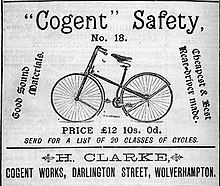Safety bicycle








A safety bicycle is a type of bicycle that became very popular beginning in the late 1880s as an alternative to the penny-farthing or ordinary and is now the most common type of bicycle. Early bicycles of this style were known as safety bicycles because they were noted for, and marketed as, being safer than the high wheelers they were replacing.[1] Even though modern bicycles use a similar design, the term is rarely used today, and may be considered obsolete.[2]
Definition
The term safety bicycle was used in the 1880s for any alternative to the penny-farthing, later historians began to use the term in a more restricted way, for the design that was a direct ancestor to most modern bicycles.[3]
Diamond frame is also sometimes used as a term for safety bicycles, even though this technically only refers to a certain type of safety bicycle. The retronym upright bicycle is used to distinguish the style from recumbent bicycles.
History
The first bicycle to be called a "safety" was designed by the English engineer Harry John Lawson (also called Henry) in 1876.[4] Unlike with penny-farthings, the rider's feet were within reach of the ground, making it easier to stop. The pedals powered the rear wheel, keeping the rider's feet safely away from the front wheel. The original model used treadles to transfer power to the rear wheel, the updated 1879 model used a chain drive, an important new technology that had previously only been used on tricycles. Lawson's safety failed to catch on, perhaps due to its increased cost, weight and complexity compared to the Penny-farthing.[4]
By 1885, the safety bicycles cataloged in Henrey Sturmey's Indispensible Handbook to the Safety Bicycle included 7 with lever front-drives, 44 with geared front-drives, and only 9 with chain rear-drives.[3] In that same year, John Kemp Starley came out with the first commercially successful safety bicycle he named the Rover.[5] It was heavier and more expensive than penny-farthings, but lighter and cheaper than tricycles of the day. In its original form it used indirect steering, later direct steering was adopted and the bicycle proved to be a hit.[6]
The safety bicycle was a big improvement on the previous penny-farthing design which it replaced. The chain drive, coupling a large front sprocket (the chainring) to a small rear sprocket (the sprocket) to multiply the revolutions of the pedals, allowed for much smaller wheels, and replaced the need for the large, directly pedaled front wheel of the penny-farthing. The smaller wheel gave a harder ride; once pneumatic tires were developed and replaced the previously used solid ones, this disadvantage was no longer an issue.
With the center of gravity low and between the wheels, rather than high and over the front hub, the safety bicycle greatly diminished the danger of "taking a header" or long fall over the handlebars. This made braking more effective and cycling, previously the reserve of spry, daring young men, safer, and therefore much more popular, especially for women.
Compared with the tricycles of the time, popular with riders less willing to take risks, the safety bicycles were lighter, mechanically more simple, and less expensive.
Its popularity soon grew to be more than the penny farthings and tricycles combined, and caused the bike boom of the 1890s.[7]
Characteristics
Safeties are now characterized by having two wheels of identical – or nearly identical – size, and a chain-driven rear wheel. The most popular form of the safety bicycle frame, consisting of two triangles, is known as a diamond frame. A similar but different frame used in safety bicycles is the step-through frame.
Despite the enormous variety of modern bicycles, recumbent bicycles are the only major variety of bicycle which do not use this same basic design.
See also
References
- ^ Brown, Sheldon. "Sheldon Brown's Bicycle Glossary". Retrieved 26 September 2009.
- ^ Oxford English Dictionary (2nd ed.). Oxford University Pre. 1989. ISBN 0-19-861186-2.
Former name for the type of bicycle now in use, differing from the 'Ordinary' in the lower position of the saddle, whereby greater safety is afforded to the rider.
{{cite book}}: Unknown parameter|coauthors=ignored (|author=suggested) (help) - ^ a b
Berto, Frank (2009). The Dancing Chain : history and development of the derailleur bicycle, Third Edition. San Francisco, CA, USA: Van der Plas Publications/Cycle Publications. p. 38. ISBN 1-892495-41-4.
{{cite book}}: Unknown parameter|coauthors=ignored (|author=suggested) (help) - ^ a b Cite error: The named reference
Herlihy_1was invoked but never defined (see the help page). - ^ "Icons of Invention: Rover safety bicycle, 1885". The Science Museum. Retrieved 2010-06-05.
- ^ Cite error: The named reference
Herlihy_3was invoked but never defined (see the help page). - ^ Cite error: The named reference
Herlihy_2was invoked but never defined (see the help page).
Cite error: A list-defined reference named "Herlihy 1" is not used in the content (see the help page).
Cite error: A list-defined reference named "Herlihy 2" is not used in the content (see the help page).
External links
- Rover safety bicycle often thought of as the icon of safety bicycles.
